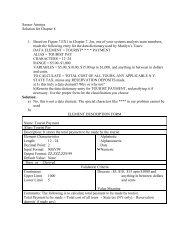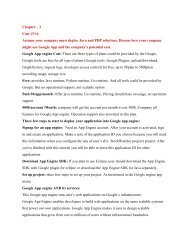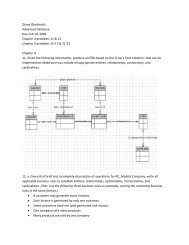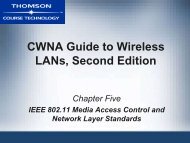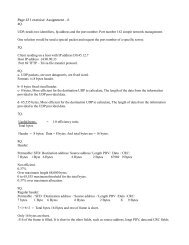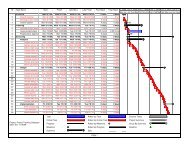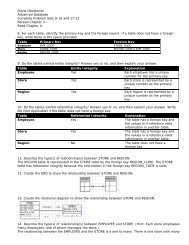Midterm Oboikovitz-48[1].pdf - Csmaster
Midterm Oboikovitz-48[1].pdf - Csmaster
Midterm Oboikovitz-48[1].pdf - Csmaster
You also want an ePaper? Increase the reach of your titles
YUMPU automatically turns print PDFs into web optimized ePapers that Google loves.
Diana <strong>Oboikovitz</strong> <strong>48</strong>/50<br />
ACSG 520, Test# 1, Part B<br />
9/30/2008<br />
1) In _______ delivery, both the deliverer of the IP packet and the destination are on<br />
the same network.<br />
A) a connectionless<br />
B) a direct<br />
C) an indirect<br />
D) none of the above<br />
2) In _______ delivery, the deliverer of the IP packet and the destination are on<br />
different networks.<br />
A) a connection-oriented<br />
B) a direct<br />
C) an indirect<br />
D) none of the above<br />
3) In _______ delivery, packets of a message are logically connected to one another.<br />
A) a connectionless<br />
B) a connection-oriented<br />
C) a direct<br />
D) none of the above<br />
4) In _______ delivery, a packet is not connected to any other packet.<br />
A) a connectionless<br />
B) a connection-oriented<br />
C) a direct<br />
D) none of the above<br />
5) In classful addressing, when a direct delivery is made, both the deliverer and<br />
receiver have the same _______.<br />
A) IP address<br />
B) hostid<br />
C) netid<br />
D) none of the above<br />
6) In classful addressing, when an indirect delivery is made, the deliverer and<br />
receiver have _______.<br />
A) the same IP address<br />
B) different netids<br />
C) the same netid<br />
D) none of the above<br />
1
7) In _______ forwarding, the full IP address of a destination is given in the routing<br />
table.<br />
A) next-hop<br />
B) network-specific<br />
C) host-specific<br />
D) default<br />
8) In _______ forwarding, the mask and destination addresses are both 0.0.0.0 in the<br />
routing table.<br />
A) next-hop<br />
B) network-specific<br />
C) host-specific<br />
D) default<br />
9) In _______ forwarding, the destination address is a network address in the routing<br />
table.<br />
A) next-hop<br />
B) network-specific<br />
C) host-specific<br />
D) default<br />
10) In _______ forwarding, the routing table holds the address of just the next hop<br />
instead of complete route information.<br />
A) next-hop<br />
B) network-specific<br />
C) host-specific<br />
D) default<br />
11) In ________ addressing, a typical forwarding module can be designed using three<br />
tables, one for each unicast class (A, B, C).<br />
A) classful<br />
B) classless<br />
C) both a and b<br />
D) none of the above<br />
12) In classful addressing, the class of the address can be found by shifting the copy<br />
of the address ____ bits to the right.<br />
A) 32<br />
B) 16<br />
C) 28<br />
D) none of the above<br />
2
13) In classful addressing we need a routing table with at least ______ columns.<br />
A) 4<br />
B) 3<br />
C) 8<br />
D) none of the above<br />
14) In classless addressing, we need a routing table with at least _______ columns.<br />
A) 4<br />
B) 3<br />
C) 8<br />
D) none of the above<br />
15) The idea of address aggregation was designed to alleviate the increase in routing<br />
table entries when using ________.<br />
A) classful addressing<br />
B) classless addressing<br />
C) both a and b<br />
D) none of the above<br />
16) The principle of ________ states that the routing table is sorted from the longest<br />
mask to the shortest mask.<br />
A) first mask matching<br />
B) shortest mask matching<br />
C) longest mask matching<br />
D) none of the above<br />
17) The use of hierarchy in routing tables can ________ the size of the routing tables.<br />
A) reduce<br />
B) increase<br />
C) both a and b<br />
D) none of the above<br />
18) _______ deals with the issues of creating and maintaining routing tables.<br />
A) Forwarding<br />
B) Routing<br />
C) Directing<br />
D) none of the above<br />
19) A _______ routing table contains information entered manually.<br />
A) static<br />
B) dynamic<br />
C) hierarchical<br />
D) none of the above<br />
3
20) A _______ routing table is updated periodically using one of the dynamic routing<br />
protocols.<br />
A) static<br />
B) dynamic<br />
C) hierarchical<br />
D) none of the above<br />
21) The input and output ports of a router perform the ________ layer functions of the<br />
router.<br />
A) physical and data link<br />
B) network<br />
C) transport<br />
D) none of the above<br />
22) The routing processor of a router performs the ________ layer functions of the<br />
router.<br />
A) physical and data link<br />
B) network<br />
C) transport<br />
D) none of the above<br />
23) A _______ address is an internetwork address with universal jurisdiction.<br />
A) physical<br />
B) logical<br />
C) a and b<br />
D) none of the above<br />
24) The logical addresses in the TCP/IP protocol suite are called _______ addresses.<br />
A) port<br />
B) IP<br />
C) Email<br />
D) none of the above<br />
25) A ________ is a local address. Its jurisdiction is over a local network.<br />
A) physical<br />
B) logical<br />
C) a and b<br />
D) none of the above<br />
26) If the sender is a host and wants to send a packet to another host on the same<br />
network, the logical address that must be mapped to a physical address is ______.<br />
A) the destination IP address in the datagram header<br />
B) the IP address of the router found in the routing table<br />
C) either a or b<br />
D) none of the above<br />
4
27) If the sender is a host and wants to send a packet to another host on another<br />
network, the logical address that must be mapped to a physical address is ______.<br />
A) the destination IP address in the datagram header<br />
B) the IP address of the router found in the routing table<br />
C) either a or b<br />
D) none of the above<br />
28) The sender is a router that has received a datagram destined for a host on another<br />
network. The logical address that must be mapped to a physical address is<br />
______.<br />
A) the destination IP address in the datagram header<br />
B) the IP address of the router found in the routing table<br />
C) either a or b<br />
D) none of the above<br />
29) The sender is a router that has received a datagram destined for a host in the same<br />
network. The logical address that must be mapped to a physical address is<br />
______.<br />
A) the destination IP address in the datagram header<br />
B) the IP address of the router found in the routing table<br />
C) either a or b<br />
D) none of the above<br />
30) In _______, a table associating a logical address with a physical address is<br />
updated manually.<br />
A) static mapping<br />
B) dynamic mapping<br />
C) physical mapping<br />
D) none of the above<br />
31) _______ is a dynamic mapping protocol in which a logical address is found for a<br />
given physical address.<br />
A) ARP<br />
B) RARP<br />
C) both a and b<br />
D) none of the above<br />
5
32) _______ is a dynamic mapping protocol in which a physical address is found for a<br />
given logical address.<br />
A) ARP<br />
B) RARP<br />
C) both a and b<br />
D) none of the above<br />
33) The target hardware address on an Ethernet is _______ in an ARP request.<br />
A) 0x000000000000<br />
B) 0.0.0.0<br />
C) variable<br />
D) class dependent<br />
34) An ARP reply is normally _______.<br />
A) broadcast<br />
B) multicast<br />
C) unicast<br />
D) none of the above<br />
35) An ARP request is normally _______.<br />
A) broadcast<br />
B) multicast<br />
C) unicast<br />
D) none of the above<br />
36) A technique called ______ is used to create a subnetting effect.<br />
A) ARP<br />
B) RARP<br />
C) proxy ARP<br />
D) none of the above<br />
37) A _______ is an ARP that acts on behalf of a set of hosts.<br />
A) ARP<br />
B) RARP<br />
C) proxy ARP<br />
D) none of the above<br />
38) A sender usually has more than one IP datagram to send to the same destination.<br />
It is inefficient to use the ARP protocol for each datagram destined for the same<br />
host or router. The solution is the _________.<br />
A) routing table<br />
B) cache table<br />
C) ARP table<br />
D) none of the above<br />
6
39) The RARP request packets are normally _________.<br />
A) broadcast<br />
B) unicast<br />
C) multicast<br />
D) none of the above<br />
40) The RARP reply packets are normally_________ .<br />
A) broadcast<br />
B) unicast<br />
C) multicast<br />
D) none of the above<br />
41) The ARP component that sends an ARP reply to the data link layer is the<br />
_______.<br />
A) cache controller<br />
B) input module<br />
C) output module<br />
D) none of the above<br />
42) The ARP component that sends an IP packet to a queue is the _______.<br />
A) cache controller<br />
B) input module<br />
C) output module<br />
D) none of the above<br />
43) The ________ protocol is the transmission mechanism used by the TCP/IP suite.<br />
A) ARP<br />
B) IP<br />
C) RARP<br />
D) none of the above<br />
44) IP is _________ datagram protocol.<br />
A) unreliable<br />
B) connectionless<br />
C) both a and b<br />
D) none of the above<br />
7
45) The term ________ means that IP provides no error checking or tracking. IP<br />
assumes the unreliability of the underlying layers and does its best to get a<br />
transmission through to its destination, but with no guarantees.<br />
A) reliable delivery<br />
B) connection-oriented delivery<br />
C) best-effort delivery<br />
D) none of the above<br />
46) A best-effort delivery service such as IP includes _______.<br />
A) error checking<br />
B) error correction<br />
C) datagram acknowledgment<br />
D) none of the above<br />
47) Given the IP address 201.14.78.65 and the subnet mask 255.255.255.224, what is<br />
the subnet address?<br />
A) 201.14.78.32<br />
B) 201.14.78.65<br />
C) 201.14.78.64<br />
D) none of the above<br />
<strong>48</strong>) The subnet mask for a class C network is 255.255.255.2<strong>48</strong>. How many<br />
subnetworks are available?<br />
A) 4<br />
B) 8<br />
C) 16<br />
D) Non of the above<br />
49) In the OSI model, as a data packet moves from the lower to the upper layers,<br />
headers are _______.<br />
A) Added<br />
B) Removed<br />
C) Updated<br />
D) Duplicated<br />
50) In the OSI model, encryption and decryption are functions of the ________ layer.<br />
A) Transport<br />
B) Session<br />
C) Presentation<br />
D) Application<br />
8


![Midterm Oboikovitz-48[1].pdf - Csmaster](https://img.yumpu.com/29229422/1/500x640/midterm-oboikovitz-481pdf-csmaster.jpg)
